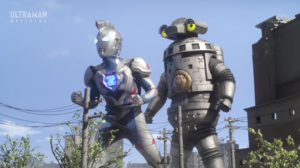As Ultraman Z comes to its end, Christopher Stewardson looks back on the series.
From June to December 2020, Ultraman Z has aired weekly via Tsuburaya Productions’ official Ultraman YouTube channel. Fans all over the world have tuned in for the latest adventures of Earth’s defence force (S.T.O.R.A.G.E.) and its members: Haruki (Kohshu Hirano), Yoko (Rima Matsuda), Yuka (Hikari Kuroki), and Captain Hebikura (Takaya Aoyagi).
At the series’ start, Devil Splinters (cells from the evil Ultraman, Belial) spread throughout the galaxy. Ultraman Zero’s apprentice, Ultraman Z, heads to Earth to track them down before they trigger monster attacks. There he fuses with Haruki, a member of Earth’s defence force, to protect the planet.
And now, the series is coming to its end. Although the recent run of Ultraman shows has produced a new series every year since 2013, something about Ultraman Z has felt a bit more special. The show has dazzled us with its charismatic ensemble cast, its beautiful special effects, and its optimistic outlook. To celebrate the series, allow me to wax lyrical about what I thought made it so good.
The Ultraman franchise is a long one, with dozens of series, heroes, and tie-in films stretching back to 1966. Without giving an exhaustive history of the franchise and its origins, Ultraman Z has offered many nods and references to several of the first few series. Whether it be Ultraman Ace’s guest appearance (titular hero of 1972’s Ultraman Ace) or sequences that use the visual style of earlier shows, Ultraman Z wears its affection for the franchise on its sleeve.

In fact, Ultraman Z has coincided perfectly with the recent Ultraman blu-ray sets from Mill Creek. While a handful of Ultra shows made their way to DVD in the early 2000s, never before has the franchise been this accessible to fans outside Japan. Consequently, nods to classic stories and characters haven’t been lost on Westerners or newcomers.
Indeed, accessibility has been one of the show’s greatest strengths. The decision to broadcast the programme on YouTube (with subtitles) was a welcome one. It’s been easier than ever to watch and enjoy, without the scramble to find a decent stream. Every weekend since June, there’s been a flurry of excited reactions from fans around the world, and being a part of that shared experience was wonderful.
Ultraman Z truly earned our excitement, largely because of its wonderful cast. Kohshu Hirano is endearing as Haruki, the S.T.O.R.A.G.E. team member whose life fuses with Ultraman Z. Haruki is goofy and playful, far from the most headstrong of the group (which is certainly Yoko or Captain Hebikura). However, those character traits juxtapose nicely with the enormous responsibility on his shoulders. As Ultraman Z is also a young character (the student of Ultraman Zero), Z and Haruki have a similar experience. Indeed, Ultraman Z is notably different from the Ultra heroes of the past, who invariably have relative omniscience over their human hosts.
The S.T.O.R.A.G.E. team are brilliantly cohesive, relying on one another for help in battles. Seeing Haruki transform into Ultraman Z, while Yoko pilots one of the team’s giant robots, has been fabulous. Teamwork always overcomes crisis. Maybe that’s a simple message, but it’s one that’s been worth hanging onto.
The show’s monster roster has been a lot of fun, too. From returning creatures like Red King, to new foes like space pirate Barossa, the series has revelled in its monster spectacle. The special effects behind these beasts have been astonishing. As with all their recent Ultraman programmes, Tsuburaya Productions continues to prove the legitimacy and beauty of practical special effects. “Beautiful” is indeed how I’d describe them. When one stops to consider just how difficult it is to produce these effects, their quality is a credit to directors like Kiyotaka Taguchi – who directed much of Ultraman Z.

Through these brilliant effects, the programme realises one of the Ultra franchise’s greatest elements: its framing of monsters as worthy of sympathy. As the series progresses, an arc emerges in which Haruki struggles to reconcile saving the day with killing the monsters. This arc is also tied to the death of Haruki’s father, lending a personal dimension to the dilemma. Haruki wants to do well – making him an earnest and likeable person – but he can’t do so without guilt over the fallen monsters. Like Haruki, the audience is forced to see monsters like Red King as thinking, feeling, and emotional creatures. Like all the best monster stories, we see the beauty in the Other.
That the opening theme song contains the line, “kindness is power”, realises this framing wonderfully. Kindness is indeed power, and Ultraman Z is optimistic that we can all harness it.
To have a series like Ultraman Z, that refuses to be cynical, that celebrates connection, and which has been a constant for half the year, has been a lot of fun. While I am sad to see the end of the series, I am thankful that it exists. We need not let the show’s optimism end with its broadcast; we can realise it in our lives.
Kindness is power.

